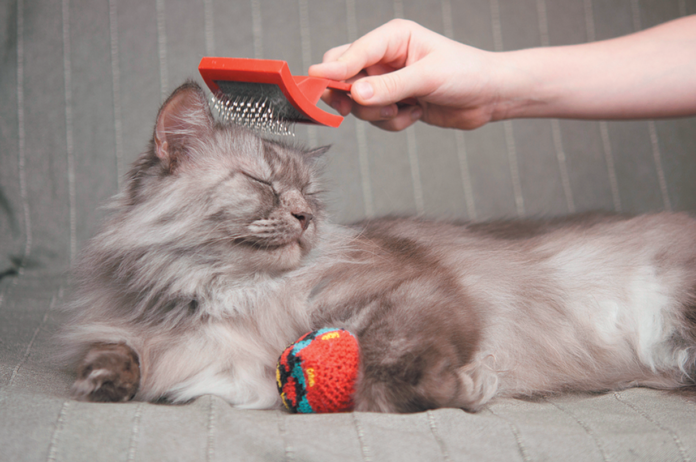A cat is never comfortable during the momentary hacking, gagging, and retching it takes to cough up a hairball. Nor is it comfortable to watch your pet having to deal with getting rid of one. But for the most part, it’s not harmful. It’s simply something that comes with being a feline.
Fortunately, most hair that makes its way to a cat’s insides you never even know about. It passes out of the body uneventfully when your pet voids. But think about it: your cat spends about half of her waking hours grooming herself. And there are little barbed attachments on her tongue that are similar to the spikes you’re not supposed to back up on when you leave the car rental parking lot. Those barbs rake off fur as she self-cleans, and that translates to a lot of hair that she licks off her body and then swallows.
It doesn’t all make its way through the stomach and then out the other end of the digestive tract. Sometimes it mixes with digestive enzymes, saliva, and a little partially digested food right in the stomach itself. And it becomes big enough that it’s easier to expel by being sent back up and into the mouth than being pushed into the large intestine and eliminated from there. The technical term for a hairball that your cat vomits up is trichobezoar. (“Tricho” is from the Greek for hair, while a “bezoar” is a solid mass of undigested material that most often forms in the stomach.)
Not surprisingly, long-haired cats such as Persians, Ragdolls, and Maine Coons are more likely to end up with hairballs than other breeds. So are cats who are no longer young. By middle age, cats have become experienced groomers and are quite good at licking and biting away debris-laden hair on their coats. But no cat is immune from hairballs, and they are especially prone to developing them at those times that they shed more.
How frequently is too frequent?
If your cat sends up a hairball every few weeks or so, it’s nothing to be concerned about, says Tufts veterinarian Elizabeth Rozanski, DVM. However, if it’s happening once a week or more, there may be a problem in the digestive tract, and it’s worth having a veterinarian do some diagnostics either to rule out a problem or diagnose and treat one.
Frequent retching or vomiting without producing a hairball should make you particularly concerned. It could mean your cat has an obstruction somewhere in her digestive tract that’s too big to send up to the mouth or is perhaps causing a blockage in the intestines. Accompanying signs may include a lack of appetite, lethargy, constipation, or diarrhea. All of these are concerns on their own, of course, but in combination with unproductive throwing up or persistent vomiting should trigger a visit to the doctor’s office in short order.
Cutting down on hairball production
If there’s nothing wrong with your pet other than the fact that she produces a lot of hairballs and they make her uncomfortable, you can take steps to make them occur less frequently.
- Groom your cat more often, perhaps once a day if she will allow. The more hair that makes its way to a brush than to your cat’s stomach, the less opportunity there is going to be for hairballs to form.
- With your vet’s go-ahead, try using an intestinal lubricant like Laxatone. Most cats take the taste of lubricants quite well. Combined with brushing, this is usually enough to solve, or at least reduce, the problem.
- Consider trying a food that’s labeled for hairball control. In truth, hairball diets do not have to be put to the scientific test to be labeled as such. But generally speaking, such diets are relatively high in fiber. The thinking is that the fiber creates enough bulk in the stomach to propel whatever’s there into the intestine and from there, out of the body. It’s a reasonable hypothesis and is certainly worth a try if your cat continues to develop a lot of hairballs despite regular brushing and administration of a lubricant.
Be aware that no combination of antidotes is going to be able to eliminate hairballs completely. Better to set a goal of “fewer” rather than “none.” But “fewer” isn’t a bad place to get to, especially considering that hairballs landing on carpets and other surfaces are not fun to clean up.




